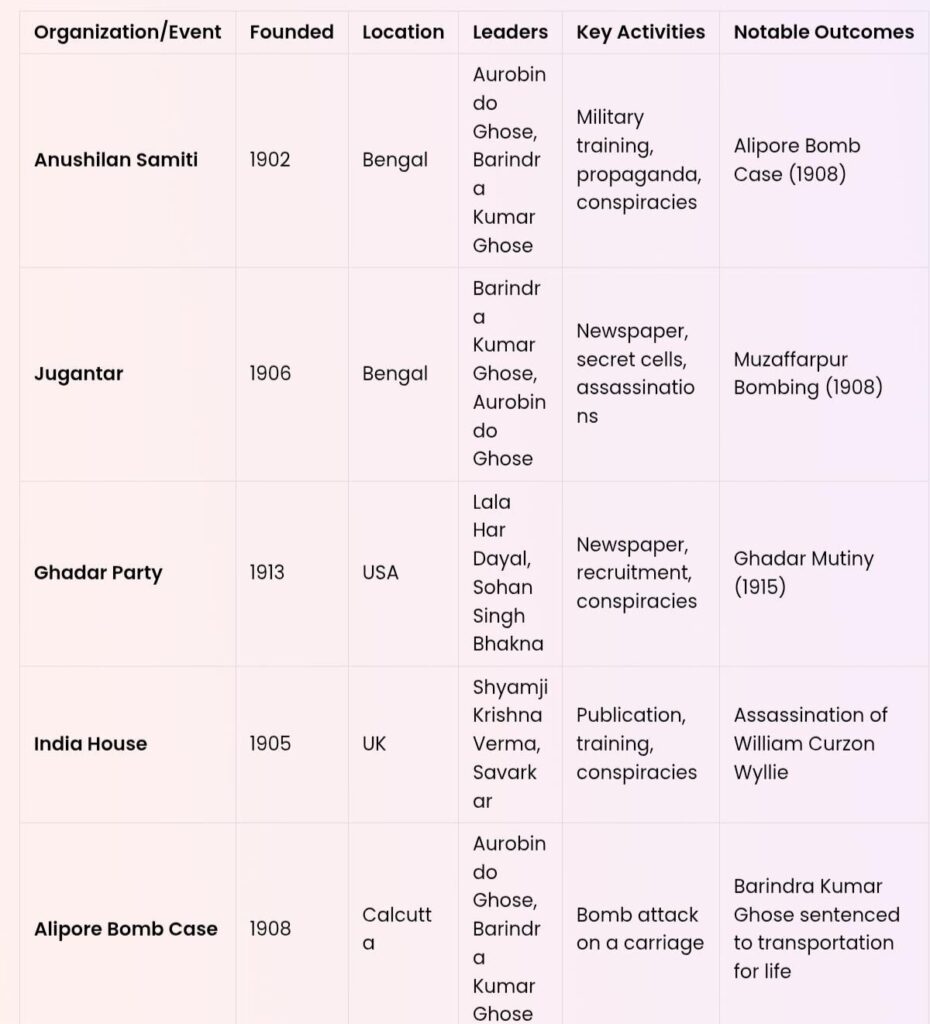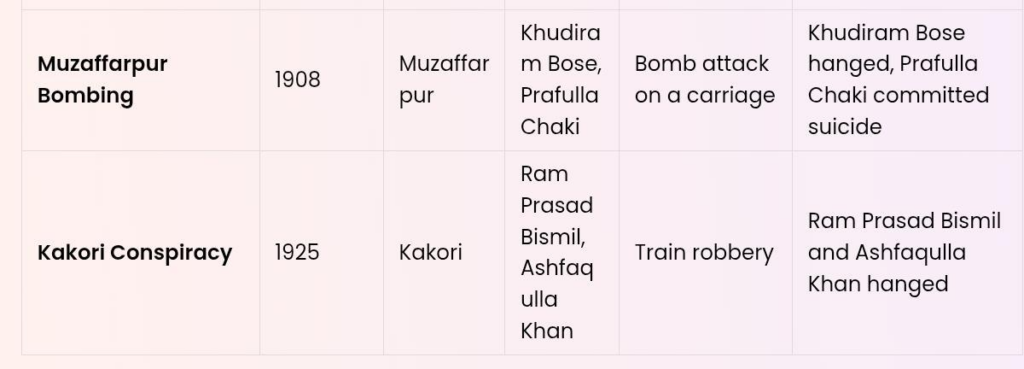- Extremists’ methods: assertive nationalism, mass action
- Tilak’s role in Ganpati festivals, Shivaji celebrations
- Revolutionary organisations: Anushilan Samiti, Jugantar
- Abroad: Ghadar Party (USA), India House (UK) – Shyamji Krishna Verma, Savarkar
- Activities: Alipore Bomb Case, Muzaffarpur Bombing, Kakori Conspiracy
Extremist Phase & Revolutionary Activities in India and Abroad
Background
The Indian National Congress, founded in 1885, initially adopted a moderate approach, focusing on petitions and constitutional methods to achieve self-governance. However, by the early 1900s, a new phase of assertive nationalism and revolutionary activities emerged, driven by the frustration with the slow pace of reforms and the desire for immediate independence. This phase, known as the Extremist Phase, saw the rise of leaders and organizations that advocated for more radical and militant methods to challenge British authority.
Extremists’ Methods: Assertive Nationalism, Mass Action
Assertive Nationalism:
- Leaders: Bal Gangadhar Tilak, Lala Lajpat Rai, Bipin Chandra Pal.
- Approach: The Extremists advocated for a more aggressive and direct approach to challenge British rule. They believed in the power of the masses and sought to mobilize them through boycotts, passive resistance, and direct action.
- Key Events:
- Swadeshi Movement (1905-1908): Initiated in response to the partition of Bengal, the movement called for the boycott of British goods and the promotion of Indian-made products.
- Surat Split (1907): The Extremists split from the Moderates at the Surat session of the Indian National Congress, leading to the formation of a more radical wing.
Mass Action:
- Boycotts: Extremists organized boycotts of British goods, institutions, and services to weaken British economic and political control.
- Passive Resistance: They encouraged non-cooperation with British laws and institutions, including the refusal to pay taxes and participate in government jobs.
- Direct Action: This included strikes, demonstrations, and other forms of civil disobedience to challenge British authority.
Tilak’s Role in Ganpati Festivals, Shivaji Celebrations
Ganpati Festivals:
- Transformation: Tilak transformed the private Ganpati festival into a public event to foster national unity and anti-British sentiment.
- Activities:
- Public Installations: Large public idols were installed, and processions were organized.
- Political Speeches: The festivals served as a platform for political speeches and the dissemination of nationalist ideas.
- Cultural Revival: The festivals helped in reviving Indian cultural traditions and instilling a sense of national pride.
Shivaji Celebrations:
- Purpose: Tilak used Shivaji’s birthday to instill historical pride and resistance against foreign rule.
- Activities:
- Celebrations: Public celebrations were organized to honor Shivaji, a symbol of resistance against Mughal rule.
- Nationalist Propaganda: The events were used to spread nationalist ideas and mobilize the masses against British rule.
Revolutionary Organisations: Anushilan Samiti, Jugantar
Anushilan Samiti:
- Formation: Founded in 1902 by Aurobindo Ghosh and Barin Ghosh.
- Purpose: To overthrow British rule through armed struggle.
- Activities:
- Propaganda: Large-scale propaganda to spread nationalist ideas.
- Underground Activities: Organized underground activities, including the planning and execution of acts of violence.
- Funding: Engaged in dacoities to raise funds for the revolutionary movement.
- Notable Members:
- Aurobindo Ghosh: Leader and ideologue.
- Barin Ghosh: Organizer and planner.
- Jatindra Nath Mukherjee (Bagha Jatin): Key figure in the revolutionary movement.
Jugantar:
- Formation: Founded in 1906 by Barin Ghosh and Aurobindo Ghosh.
- Purpose: To spread nationalist ideas and organize revolutionary activities.
- Activities:
- Publications: Published articles and editorials in the newspaper ‘Jugantar’ to criticize British rule and call for armed resistance.
- Acts of Violence: Planned and executed acts of violence, including the Muzaffarpur Bombing and the Alipore Bomb Case.
- Notable Members:
- Aurobindo Ghosh: Leader and ideologue.
- Barin Ghosh: Organizer and planner.
- Khudiram Bose: Young revolutionary involved in the Muzaffarpur Bombing.
- Prafulla Chaki: Young revolutionary involved in the Muzaffarpur Bombing.
Abroad: Ghadar Party (USA), India House (UK) – Shyamji Krishna Verma, Savarkar
Ghadar Party (USA):
- Formation: Founded in 1913 by Indian immigrants in the United States.
- Purpose: To support the Indian revolutionary movement and organize a revolt among Indian soldiers.
- Activities:
- Publications: Published the ‘Ghadar’ newspaper to spread nationalist messages and critique British rule.
- Recruitment: Organized and mobilized Indian immigrants to support the revolutionary movement.
- Revolt Planning: Planned to send Indian immigrants back to India to organize a revolt among Indian soldiers.
- Notable Members:
- Lala Har Dayal: Founder and leader.
- Sohan Singh Bhakna: Key organizer.
- Kartar Singh Sarabha: Young revolutionary and key figure.
India House (UK):
- Formation: Established in 1905 by Shyamji Krishna Verma and V.D. Savarkar.
- Purpose: To support Indian revolutionaries and organize activities.
- Activities:
- Support and Shelter: Provided a safe haven for Indian revolutionaries.
- Publications: Published nationalist literature and organized political discussions.
- Assassinations: Involved in the assassination of British officials, such as the murder of Sir Curzon Wyllie.
- Notable Members:
- Shyamji Krishna Verma: Founder and leader.
- V.D. Savarkar: Key organizer and ideologue.
- Madan Lal Dhingra: Young revolutionary involved in the assassination of Sir Curzon Wyllie.
Activities: Alipore Bomb Case, Muzaffarpur Bombing, Kakori Conspiracy
Alipore Bomb Case:
- Event: In 1908, a bomb was thrown at a carriage in Muzaffarpur, Bihar, killing two British women.
- Participants:
- Khudiram Bose: Young revolutionary.
- Prafulla Chaki: Young revolutionary.
- Aurobindo Ghosh: Leader and ideologue.
- Barin Ghosh: Organizer and planner.
- Outcome:
- Khudiram Bose: Hanged.
- Prafulla Chaki: Committed suicide.
- Aurobindo Ghosh: Acquitted.
- Others: Deported and harshly punished.
Muzaffarpur Bombing:
- Event: In April 1908, Khudiram Bose and Prafulla Chaki attempted to assassinate a British official but killed two British women.
- Participants:
- Khudiram Bose: Young revolutionary.
- Prafulla Chaki: Young revolutionary.
- Outcome:
- Khudiram Bose: Hanged.
- Prafulla Chaki: Committed suicide.
Kakori Conspiracy:
- Event: In 1925, a group of revolutionaries looted a train carrying government money to finance the revolutionary movement.
- Participants:
- Ramprasad Bismil: Leader and organizer.
- Ashfaqulla Khan: Key figure.
- Roshan Singh: Key figure.
- Rajendra Lahiri: Key figure.
- Outcome:
- Ramprasad Bismil: Hanged.
- Ashfaqulla Khan: Hanged.
- Roshan Singh: Hanged.
- Rajendra Lahiri: Hanged.
Summary Table


Conclusion
The Extremist Phase and Revolutionary Activities in India and abroad were pivotal in the struggle for independence. These movements, characterized by assertive nationalism and mass action, sought to challenge British rule through more radical and militant methods. Key figures like Bal Gangadhar Tilak, Aurobindo Ghose, and Lala Har Dayal played crucial roles in mobilizing the masses and organizing revolutionary activities. Organizations such as the Anushilan Samiti, Jugantar, Ghadar Party, and India House provided the necessary infrastructure and support for these efforts. Notable events like the Alipore Bomb Case, Muzaffarpur Bombing, and Kakori Conspiracy highlighted the intensity and determination of the revolutionaries. Despite the severe consequences, including arrests and executions, these activities significantly contributed to the broader movement for Indian independence, inspiring future generations to continue the fight.
MCQ:-
1.Question: Match the following leaders with their associated publications or organizations:
Scribd
Bal Gangadhar Tilak
Lala Lajpat Rai
Aurobindo Ghosh
Vinayak Damodar Savarkar
a. Kesari
b. The Indian War of Independence, 1857
c. Vande Mataram
d. Punjab Kesari
Options:
A) 1-a, 2-d, 3-c, 4-b
B) 1-b, 2-c, 3-a, 4-d
C) 1-c, 2-a, 3-d, 4-b
D) 1-d, 2-b, 3-a, 4-c
Answer: A) 1-a, 2-d, 3-c, 4-b
Explanation: Bal Gangadhar Tilak was associated with the newspaper ‘Kesari’; Lala Lajpat Rai was known as ‘Punjab Kesari’; Aurobindo Ghosh edited ‘Bande Mataram’; and Vinayak Damodar Savarkar authored ‘The Indian War of Independence, 1857’.
2. Question: Which of the following statements about revolutionary activities abroad is/are correct?
India House in London was established by Shyamji Krishna Verma.
The Ghadar Party was founded in the United Kingdom to incite rebellion in India.
Vinayak Damodar Savarkar was associated with both India House and the Ghadar Party.
Options:
A) Only 1
B) Only 2
C) 1 and 3
D) 1, 2, and 3
Answer: A) Only 1
Explanation: India House in London was indeed established by Shyamji Krishna Verma. The Ghadar Party, however, was founded in the United States, not the United Kingdom. Vinayak Damodar Savarkar was associated with India House but not with the Ghadar Party.
3. Question: Arrange the following events in chronological order:
Muzaffarpur Bombing
Kakori Conspiracy
Alipore Bomb Case
Delhi Conspiracy Case
Options:
A) 1, 3, 4, 2
B) 3, 1, 2, 4
C) 1, 3, 2, 4
D) 3, 1, 4, 2
Answer: D) 3, 1, 4, 2
Explanation: The correct chronological order is: Alipore Bomb Case (1908), Muzaffarpur Bombing (1908), Delhi Conspiracy Case (1912), and Kakori Conspiracy (1925).
4. Question: Which of the following festivals were utilized by Bal Gangadhar Tilak to promote cultural nationalism and mobilize the masses?
A) Diwali and Holi
B) Ganapati and Shivaji festivals
C) Durga Puja and Navratri
D) Baisakhi and Onam
Wikipedia
Answer: B) Ganapati and Shivaji festivals
Explanation: Bal Gangadhar Tilak popularized the public celebration of Ganapati and Shivaji festivals to instill a sense of unity and nationalism among Indians during the freedom struggle.




